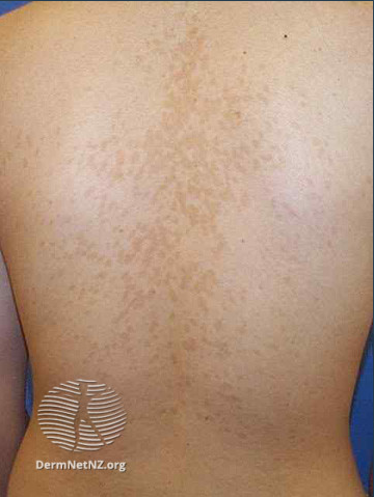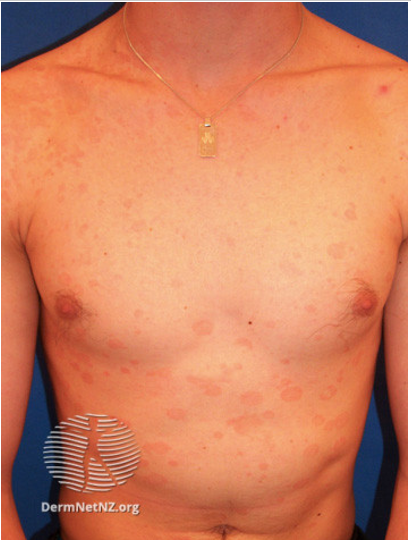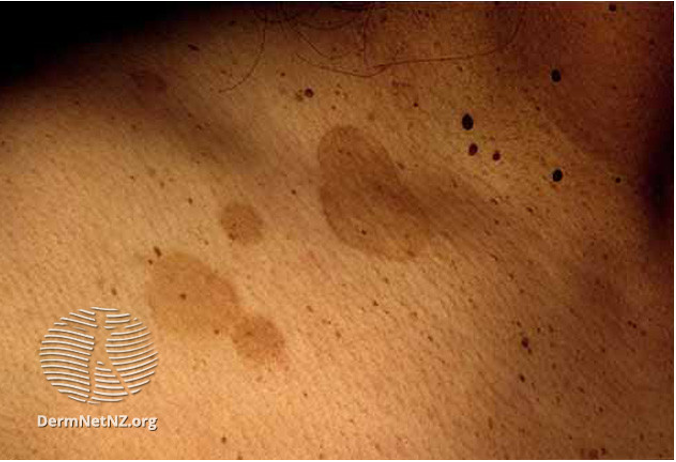Comments from the Expert Advisory Group
Pityriasis versicolor (also known as tinea versicolor) is a fungal infection of the skin caused by Malassezia yeasts.
Pityriasis versicolor responds well to medical therapy, but recurrence is common and prophylactic therapy sometimes may be necessary.
After treatment, skin might not go back to its normal colour for several months. This does not mean the treatment didn't work. It just takes time for the skin to heal.
Take skin scrapings for culture if not localised.
Skin sampling instruction
- Swabs are of little value, unless there is insufficient material obtained by scraping
- Wipe off any treatment creams before sampling
- Keep any samples at room temperature. Do not refrigerate as dermatophytes are inhibited at low temperatures, and humidity facilitates the growth of contaminants
- Samples should be collected into folded dark paper squares. Secure dark paper squares with a paper clip and place in a plastic bag, or use commercially available fungal packets
Skin scrapings
- Scrape skin from the advancing edge of lesion; use a blunt scalpel blade or similar
- 5mm2 of skin flakes are needed for microscopy and culture
|
Image 1: Pityriasis versicolor
Image source: Dermnet
|
 |
|
Image 2: Pityriasis versicolor
Image source: Dermnet
|
 |
|
Image 3: Pityriasis versicolor
Image source: Dermnet
|
 |
Treatment
| Pityriasis versicolor: 1st choice options |
| Drug |
Dose |
Duration |
Notes |
|
Ketoconazole 2% shampoo
|
Once every 24 hours
|
1-5 days
|
Leave preparation on for 3–5 minutes before rinsing.
Licensed for use for age 12 years and over.
|
|
OR
Selenium sulphide shampoo (Selsun®)
|
Once every 24 hours
|
7 days
|
Apply to the affected area and leave on for 10 minutes before rinsing off.
Diluting with a small amount of water prior to application can reduce irritation.
Selsun® is only licensed for use on the scalp.
|
|
OR
Clotrimazole 1% cream
|
Every 8 to 12 hours
|
7 – 14 days
|
For smaller areas.
|
|
OR
Terbinafine 1% cream
|
Every 12 to 24 hours
|
14 days
|
For smaller areas.
Not licensed for use in children.
|
|
Pityriasis versicolor: 2nd choice options (Adults)
Oral therapy is reserved for patients with disease refractory to topical therapy or widespread disease that makes the application of topical therapy difficult.
|
| Drug |
Dose |
Duration |
Notes |
|
Fluconazole*
(for extensive disease)
|
300mg once weekly
|
1 – 3 weeks
|
Use with caution in patients with hepatic dysfunction.
Avoid fluconazole (and all oral azoles) in pregnancy.
See HPRA caution in women of childbearing potential*
|
|
OR
Fluconazole*
(for extensive disease)
|
50mg every 24 hours
|
2 – 4 weeks
|
Use with caution in patients with hepatic dysfunction.
Avoid fluconazole (and all oral azoles) in pregnancy.
See HPRA caution in women of childbearing potential*
|
|
OR
Itraconazole**
(for resistant disease or second line treatment)
|
200mg every 24 hours |
7 days |
Capsules should be taken immediately after a meal for maximal absorption.
Not recommended in patients with active or chronic liver disease.
Avoid itraconazole (and all oral azoles) in pregnancy**
|
*Women of childbearing potential, for whom fluconazole is prescribed, should be informed of the potential risks to the foetus:
- After single dose treatment, a washout period of one week is recommended before pregnancy.
- For longer courses of treatment appropriate contraception should be considered throughout the treatment period and for one week after the final dose.
** Women of childbearing potential taking itraconazole should use contraceptive precautions. Effective contraception should be continued until the menstrual period following the end of itraconazole therapy.
|
Patient Information
- Doses are oral and for adults unless otherwise stated
- Safety in Pregnancy and Lactation
- Drug interactions table. Extensive drug interactions for clarithromycin, fluoroquinolones, azole antifungals and rifampicin. Many antibiotics increase the risk of bleeding with anticoagulants.
- Visit the Health Products Regulatory Authority (HPRA) website for detailed drug information (summary of product characteristics and patient information leaflets). Dosing details, contraindications and drug interactions can also be found in the Irish Medicines Formulary (IMF) or other reference sources such as British National Formulary (BNF) / BNF for children (BNFC).
Reviewed December 2022, minor update March 2025
